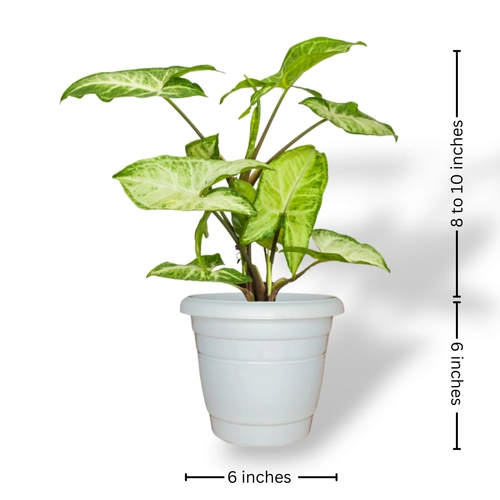Syngonium Pixie Plant
Description
- Syngonium Pixie, also known as Syngonium podophyllum 'Pixie', is a charming and compact variety of the Syngonium plant. This tropical houseplant is prized for its small size, lush foliage, and unique leaf patterns. The Syngonium Pixie is an ideal choice for small spaces, terrariums, and tabletop displays.
Features & Benefits
- Known for its air-purifying qualities, helping to remove toxins and improve indoor air quality, promoting a healthier environment.
- Resilient and adaptable, making it suitable for beginners or those with limited gardening experience.
- Adds a touch of color and liveliness to indoor spaces, perfect for desktops or shelves.
- Features arrowhead-shaped leaves with a compact growth habit, often displaying vibrant variegation of green and white.
- Grows as a compact bushy plant, making it suitable for small spaces or terrariums.
Care Guide
- Light: Syngonium Pixie thrives in bright, indirect light but can tolerate lower light conditions. Place it near a window where it can receive filtered sunlight or in well-lit areas away from direct sun exposure, as too much sunlight can scorch the leaves.
- Watering: Allow the soil to dry out slightly between waterings. Water the Syngonium Pixie thoroughly when the top inch of soil feels dry to the touch, ensuring that excess water drains away to prevent waterlogging and root rot.
- Soil: Plant Syngonium Pixie in well-draining potting mix, such as a blend of peat moss, perlite, and compost. Ensure the pot has drainage holes to allow excess water to escape and prevent waterlogging.
- Humidity: Syngonium Pixie thrives in moderate to high humidity environments. Increase humidity levels by misting the leaves regularly, placing a humidity tray filled with water and pebbles nearby, or using a room humidifier, especially during the dry winter months.
- Fertilization: Feed Syngonium Pixie with a balanced liquid fertilizer diluted to half strength every 4-6 weeks during the growing season (spring and summer). Reduce fertilization frequency or stop altogether during the dormant winter months.
- Pruning: Trim any leggy or overgrown stems as needed to maintain the plant's compact shape and encourage bushier growth. Use clean, sharp pruning shears to make clean cuts, and propagate any trimmed cuttings to create new plants.





